
Johannes Vermeer was a Dutch Baroque Period painter who specialized in domestic interior scenes of middle-class life. During his lifetime, he was a moderately successful provincial genre painter, recognized in Delft and The Hague. Nonetheless, he produced relatively few paintings and evidently was not wealthy, leaving his wife and children in debt at his death.
NewTek, Inc. is a San Antonio, Texas-based hardware and software company that produces live and post-production video tools and visual imaging software for personal computers. The company was founded in 1985 in Topeka, Kansas, United States, by Tim Jenison and Paul Montgomery. On 1 April 2019, it was announced that NewTek would be wholly acquired by Vizrt.

Chiaroscuro, in art, is the use of strong contrasts between light and dark, usually bold contrasts affecting a whole composition. It is also a technical term used by artists and art historians for the use of contrasts of light to achieve a sense of volume in modelling three-dimensional objects and figures. Similar effects in cinema, and black and white and low-key photography, are also called chiaroscuro.
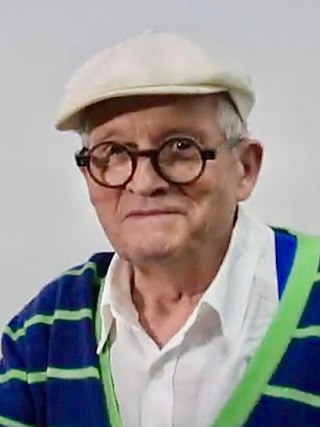
David Hockney is an English painter, draftsman, printmaker, stage designer, and photographer. As an important contributor to the pop art movement of the 1960s, he is considered one of the most influential British artists of the 20th century.
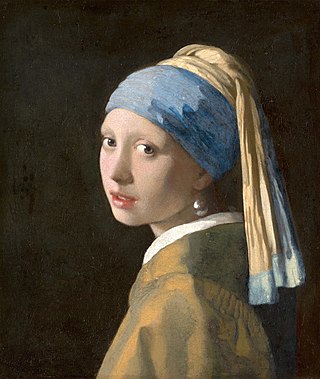
Girl with a Pearl Earring is an oil painting by Dutch Golden Age painter Johannes Vermeer, dated c. 1665. Going by various names over the centuries, it became known by its present title towards the end of the 20th century after the earring worn by the girl portrayed there. The work has been in the collection of the Mauritshuis in The Hague since 1902 and has been the subject of various literary and cinematic treatments.

The Music Lesson, Woman Seated at a Virginal or A Lady at the Virginals with a Gentleman by Johannes Vermeer is a painting of a young female pupil receiving a music lesson from a man. The man's mouth is slightly agape giving the impression that he is singing along with the music that the young girl is playing. This suggests that there is a relationship between the two figures and the idea of love and music being bridged together. This was a common theme among Netherlandish art in this time period. Vermeer consistently used the same objects within his paintings such as the draped rug, the white water jug, various instruments, tiled floor and windows that convey light and shadows. This is one of few paintings produced by Vermeer which were kept in his home until his death in 1675 when his family was forced to sell them. It became a part of the Royal Collection, and it is currently on display in the Queen's Gallery at Buckingham Palace in London.

The Hockney–Falco thesis is a theory of art history, advanced by artist David Hockney and physicist Charles M. Falco. Both claimed that advances in realism and accuracy in the history of Western art since the Renaissance were primarily the result of optical instruments such as the camera obscura, camera lucida, and curved mirrors, rather than solely due to the development of artistic technique and skill. Nineteenth-century artists' use of photography had been well documented.
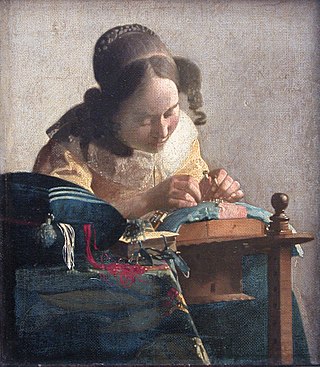
The Lacemaker is a painting by the Dutch artist Johannes Vermeer (1632–1675), completed around 1669–1670 and held in the Louvre, Paris. The work shows a young woman wearing a yellow bodice, holding up a pair of bobbins in her left hand as she carefully places a pin in the pillow on which she is making her bobbin lace. At 24.5 cm x 21 cm, the work is the smallest of Vermeer's paintings, but in many ways one of his most abstract and unusual. The canvas used was cut from the same bolt as that used for A Young Woman Seated at the Virginals, and both paintings seem to have had identical dimensions originally.
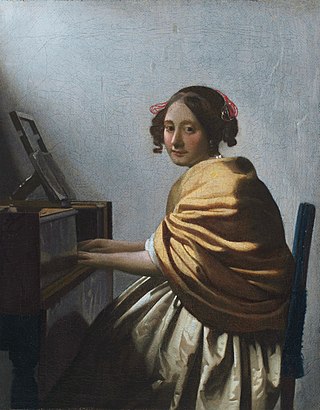
A Young Woman Seated at the Virginals is a painting generally attributed to Johannes Vermeer, though this was for a long time widely questioned. A series of technical examinations from 1993 onwards confirmed the attribution. It is thought to date from c.1670 and is now in part of the Leiden Collection in New York. It should not be confused with Young Woman Seated at a Virginal in the National Gallery, London, also by Vermeer.
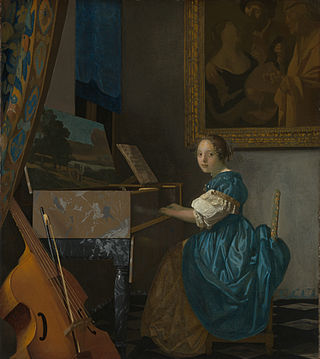
Lady Seated at a Virginal, also known as Young Woman Seated at a Virginal, is a genre painting created by the Dutch Golden Age painter Johannes Vermeer in about 1670–1672 and now in the National Gallery, London.

Lady Standing at a Virginal is a genre painting created by the Dutch artist Johannes Vermeer in about 1670–1672, now in the National Gallery, London.

Officer and Laughing Girl, also known as Officer and a Laughing Girl, Officer With a Laughing Girl or De Soldaat en het Lachende Meisje, was painted by the Dutch artist Johannes Vermeer between 1655 and 1660. It was painted in oil on canvas, typical of most Dutch artists of the time, and is 50.5 by 46 cm. It is now one of three pictures by Vermeer in The Frick Collection in New York
Jonathan Janson is an American painter and art historian.
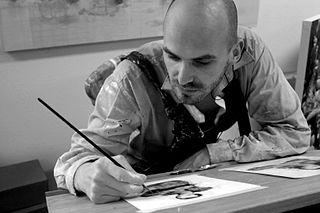
Chris Berens is a Dutch painter. While he takes inspiration from the quality of light in the paintings of Vermeer and Rembrandt, his themes lie more within the realms of surrealism and visionary art than traditional painting. Although his work is completely hand-painted, his paintings are often assumed to be digital photographic manipulation. He lives in Amsterdam with his wife Esther and their daughters Emma & Juno Leeuwenhart.
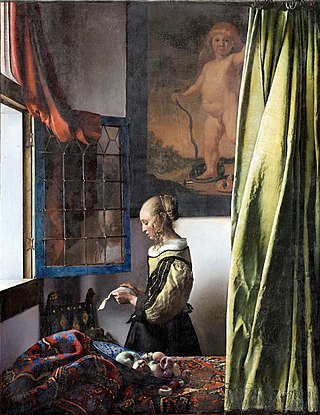
Girl Reading a Letter at an Open Window is an oil painting by Dutch Golden Age painter Johannes Vermeer. Completed in approximately 1657–59, the painting is on display at the Gemäldegalerie in Dresden, which has held it since 1742. For many years, the attribution of the painting—which features a young Dutch woman reading a letter before an open window—was lost, with first Rembrandt and then Pieter de Hooch being credited for the work before it was properly identified in 1880. After World War II, the painting was briefly in possession of the Soviet Union. In 2017, tests revealed that the painting had been altered after the painter's death.

Bigger Trees Near Warter or ou Peinture en Plein Air pour l'age Post-Photographique is a large landscape painting by British artist David Hockney. Measuring 460 by 1,220 centimetres or 180 by 480 inches, it depicts a coppice near Warter, Pocklington in the East Riding of Yorkshire and is the largest painting Hockney has completed.

The Procuress is the name given to a number of similar paintings by the Dutch Golden Age painter Dirck van Baburen. The painting is in the Caravaggiesque style of the Utrecht school.

The Guitar Player is an oil painting by Dutch Golden Age artist Johannes Vermeer, dated c. 1672. This work of art is one of Vermeer's final artistic activities, providing insight into the techniques he mastered and approaches to painting he favored. The painting has been on display at Kenwood House, London since the 1920s, as part of the Iveagh Bequest collection. After being recovered from a theft in 1974, when the painting was held for ransom, The Guitar Player was returned to Kenwood House.

Nigel Konstam was a British sculptor and art historian who has researched the history of art and lectured internationally on art historical subjects. He specialised in exploring the development of Man's ability to understand what he sees and challenged orthodoxy on important turning points in art history.

Johannes Vermeer was a Dutch Baroque Period painter who specialized in domestic interior scenes of middle class life. His works have been a common theme in literature and films in popular culture since the rediscovery of his works by 20th century art scholars.


















